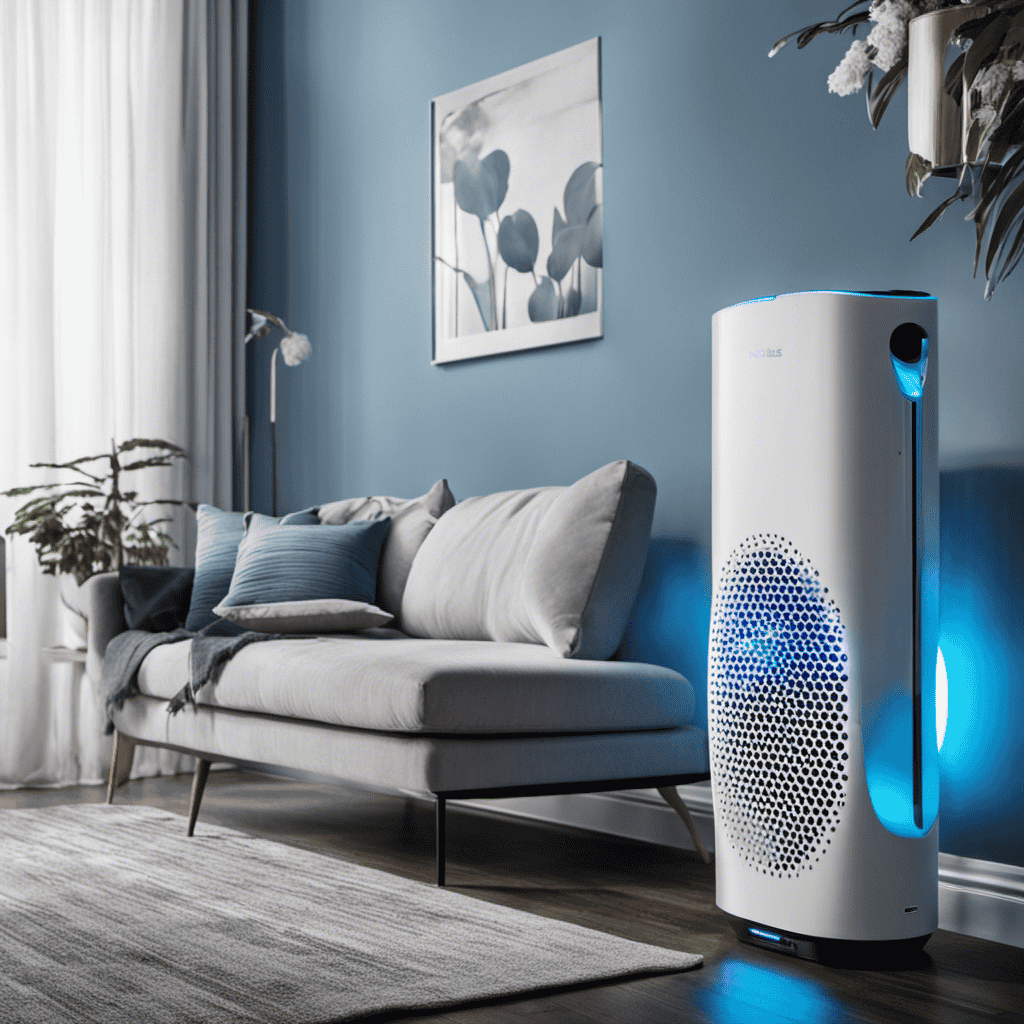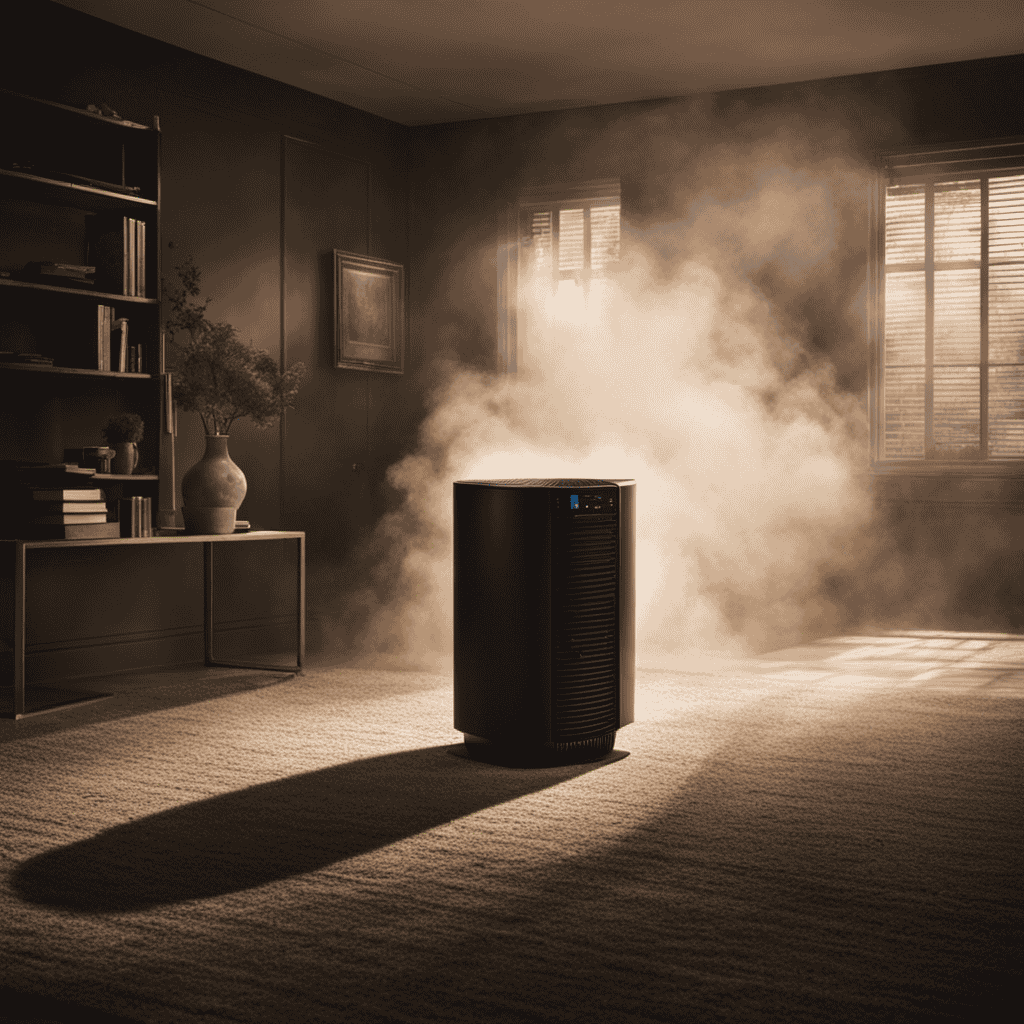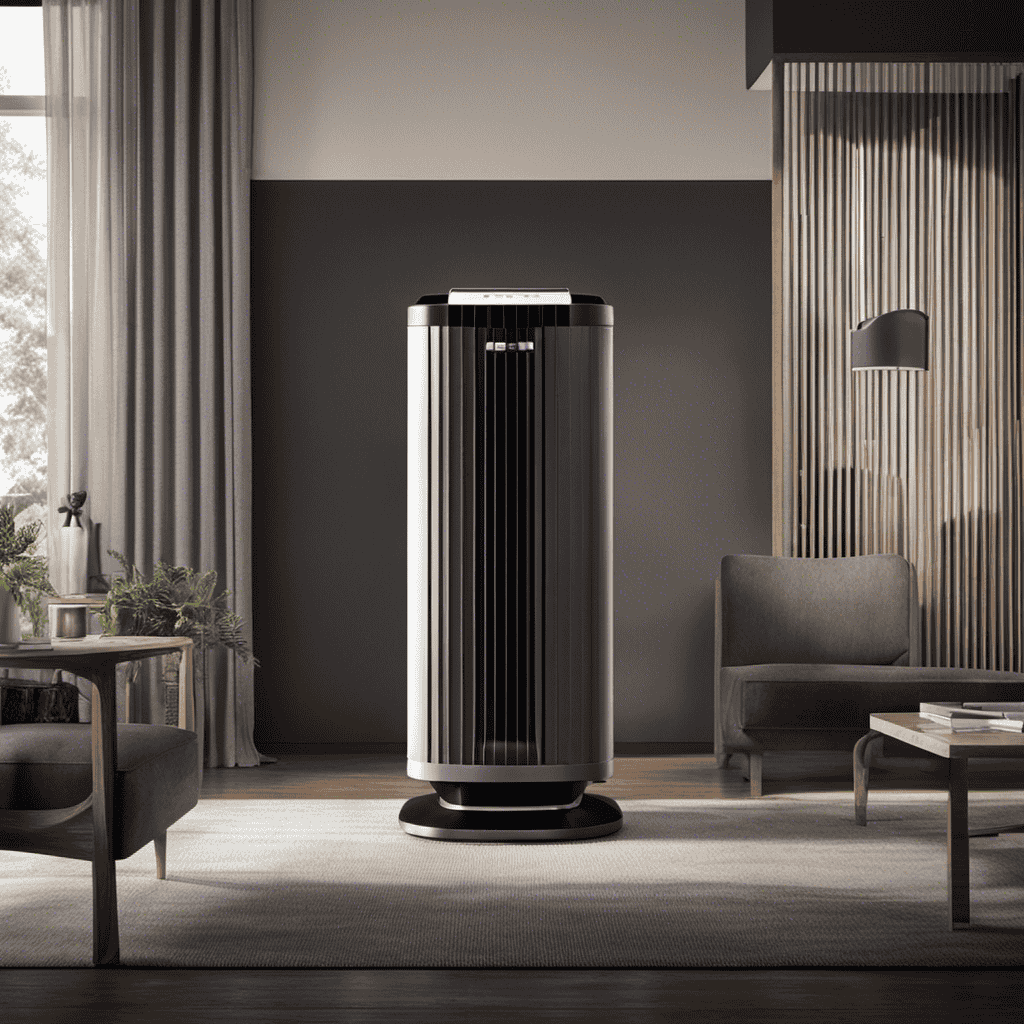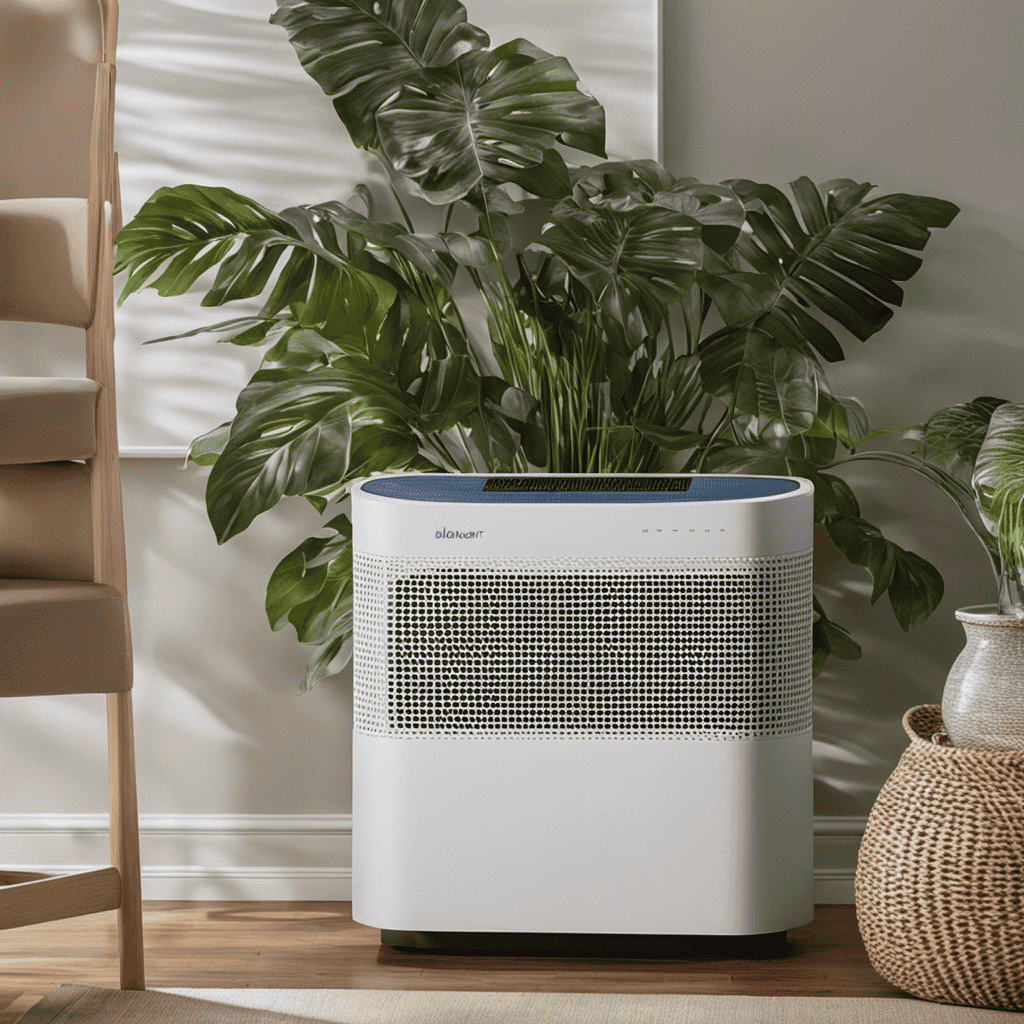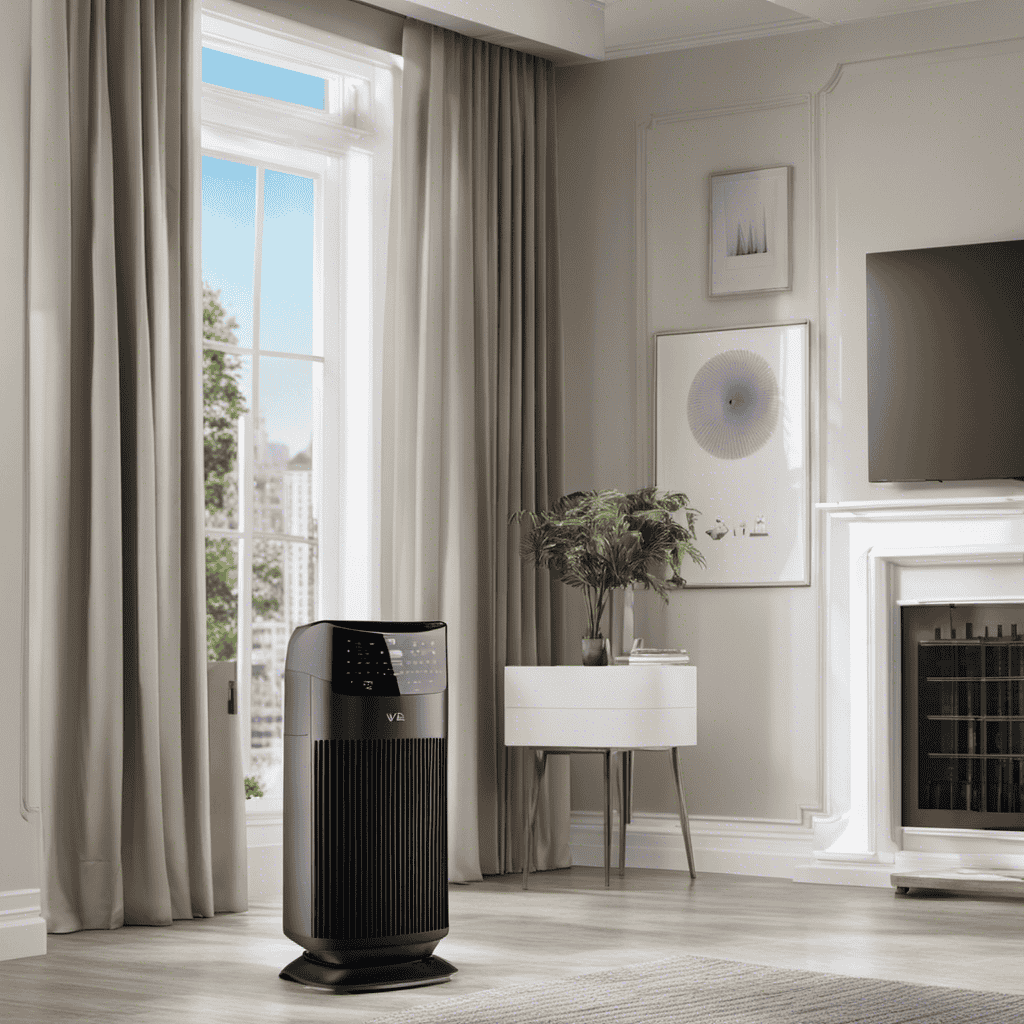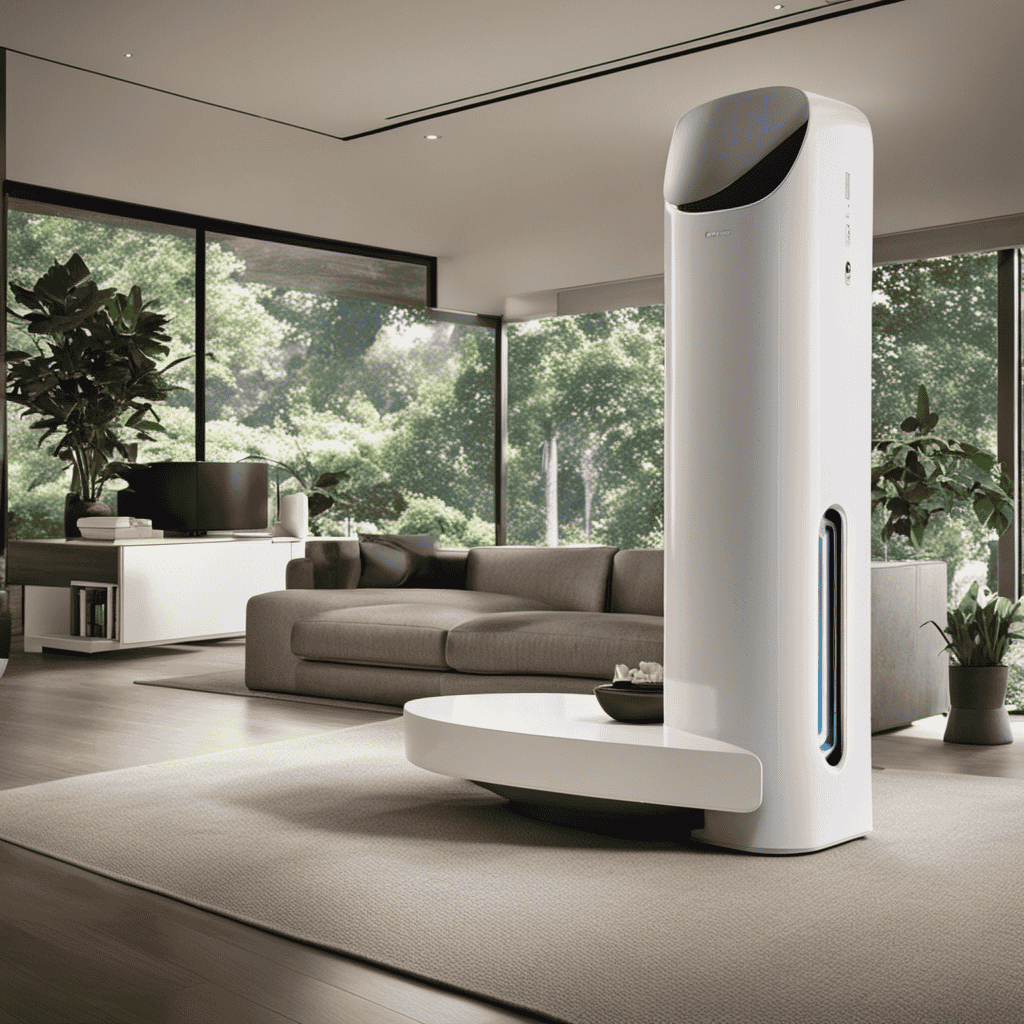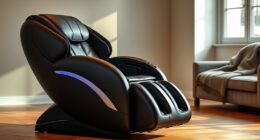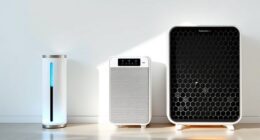As someone who is passionate about air purifiers, I was amazed to learn about the significant impact UV technology has on enhancing the air quality indoors.
Did you know that airborne germs and bacteria can be effectively eliminated with the help of UV light?
In this article, I will explain the purpose of the UV button on your air purifier, delve into the science behind UV-C light, and provide tips for using it effectively.
So, let’s dive in and enhance our understanding of the importance of UV technology in air purification.
Key Takeaways
- The UV button activates the UV purification process in air purifiers, which effectively eliminates airborne germs and bacteria.
- UV-C technology in air purifiers ensures that the air we breathe is free from microorganisms by damaging their DNA and RNA.
- The UV button improves indoor air quality, reduces the risk of respiratory illnesses, and creates a cleaner and healthier indoor environment.
- Installing an air purifier with a UV button is a wise choice for maintaining a clean and safe living environment.
The Importance of UV Technology in Air Purifiers
You may be wondering why there is a UV button on your air purifier. The answer lies in the importance of UV technology in air purifiers.
UV-C technology, also known as ultraviolet germicidal irradiation, is a powerful tool in maintaining the cleanliness and health of the air we breathe. UV-C light has the ability to destroy microorganisms such as bacteria, viruses, and mold spores, reducing the risk of airborne infections.
In healthcare settings, where maintaining a sterile environment is crucial, UV-C technology plays a vital role in preventing the spread of harmful pathogens.
By incorporating UV-C technology into air purifiers, we can ensure that the air we breathe is free from harmful microorganisms.
Regular air purifier maintenance, including cleaning the UV-C lamp and replacing it when necessary, is essential to ensure the effectiveness of this technology.
Understanding the Purpose of the UV Button
To understand the purpose of the UV button, it’s helpful to know that it helps to eliminate harmful particles in the air. The UV button function in an air purifier is designed to activate the UV purification process, which uses ultraviolet light to kill viruses, bacteria, and other microorganisms. This process is highly effective in improving indoor air quality and reducing the risk of respiratory illnesses. The UV light emitted by the air purifier damages the DNA structure of these harmful particles, rendering them inert and unable to reproduce. This ensures that the air you breathe is clean and free from harmful pathogens. The benefits of UV purification include improved respiratory health, reduced spread of germs, and enhanced overall well-being. Installing an air purifier with a UV button is a wise choice to maintain a healthy home environment.
| Benefits of UV Purification |
|---|
| 1. Improved respiratory health |
| 2. Reduced spread of germs |
| 3. Elimination of viruses and bacteria |
| 4. Enhanced indoor air quality |
| 5. Overall well-being |
How UV Light Helps Eliminate Airborne Germs and Bacteria
UV light has powerful germ-fighting capabilities that can help eliminate airborne pathogens and bacteria. It works by damaging the DNA of microorganisms, preventing them from reproducing and rendering them harmless.
When used in conjunction with an air purifier, UV light can significantly enhance its effectiveness by targeting and neutralizing harmful airborne particles, providing cleaner and healthier indoor air.
UV Light Germ-Fighting Power
There’s a UV button on your air purifier because it utilizes UV light to fight germs. UV light, specifically UV-C, has several benefits when it comes to eliminating airborne germs and bacteria.
First, UV-C light has the ability to disrupt the DNA and RNA of microorganisms, preventing them from reproducing. This leads to the destruction of their genetic material, rendering them unable to infect or spread.
Additionally, UV-C light has a broad spectrum of effectiveness, meaning it can effectively kill various types of bacteria and viruses. However, it is important to understand and follow UV-C safety precautions.
Direct exposure to UV-C light can be harmful to humans, causing skin burns and eye damage. Therefore, the UV button on your air purifier should only be used when the room is unoccupied, and it is essential to follow the manufacturer’s guidelines for safe usage.
Air Purifier Effectiveness Explained
When using an air purifier, you’ll notice a significant reduction in airborne particles such as dust, pollen, and pet dander. This is because air purifiers work by filtering the air, trapping these particles and preventing them from circulating in your living space.
It’s important to properly maintain your air purifier to ensure its effectiveness and to minimize potential health risks. Here are three key aspects of air purifier maintenance:
-
Regular filter replacement: Filters in air purifiers need to be replaced at recommended intervals to maintain their efficiency in capturing particles. Neglecting filter replacement can lead to reduced performance and compromised air quality.
-
Cleaning the unit: Regularly cleaning the exterior and interior of your air purifier helps prevent the buildup of dust and other contaminants, ensuring optimal performance.
-
Monitoring air quality: It’s important to regularly check the air quality in your living space to assess the effectiveness of your air purifier. This can be done using air quality monitors or by observing any improvements in your respiratory health.
The Science Behind UV-C Light in Air Purification
UV-C light is a powerful tool in the fight against germs and bacteria, thanks to its ability to effectively kill these pathogens. When airborne pathogens come into contact with UV-C light, their DNA is damaged, rendering them unable to reproduce and causing their eventual demise.
This makes UV-C light a highly effective method for eradicating airborne pathogens and purifying the air we breathe.
UV-C Kills Germs
You can activate the UV button on your air purifier to effectively kill germs. The UV-C light technology used in air purifiers has shown remarkable germ-killing benefits. Here are three reasons why the UV-C light is so effective:
-
UV-C light destroys the DNA of germs: When exposed to UV-C light, the genetic material of germs gets damaged, preventing them from reproducing and spreading.
-
UV-C light eliminates airborne pathogens: The high-intensity UV-C light can neutralize bacteria, viruses, and other harmful microorganisms that are present in the air.
-
UV-C light kills germs on surfaces: In addition to purifying the air, the UV-C light can also sanitize surfaces by directly targeting and eliminating germs.
The effectiveness of UV-C in killing germs has been extensively studied and validated. By activating the UV button on your air purifier, you can ensure a cleaner and healthier environment in your home or office.
Airborne Pathogen Eradication
To effectively eradicate airborne pathogens, activate the UV button on your air purifier and witness the remarkable germ-killing benefits of UV-C light technology.
Air purifier filters are designed to trap and remove particles from the air, but they may not be effective against pathogens like bacteria and viruses. This is where UV-C light comes in. UV-C light with a wavelength of 254 nanometers has been proven to effectively kill germs by disrupting their DNA structure.
When you activate the UV button on your air purifier, it emits a powerful UV-C light that sterilizes the air passing through the purifier. This ensures that any airborne pathogens are neutralized, providing you with cleaner and healthier air.
Uv-C’s Purification Effectiveness
Activated UV-C light effectively neutralizes airborne pathogens, providing cleaner and healthier air in your surroundings. UV-C light, a type of ultraviolet light, has been proven to have a significant impact on respiratory health by eliminating harmful viruses and bacteria.
Here are three key ways UV-C can help improve the air you breathe:
-
Virus Elimination: UV-C light damages the DNA and RNA of viruses, rendering them unable to replicate and infect. This helps prevent the spread of viruses, including those that cause respiratory illnesses such as the flu or common cold.
-
Bacteria Eradication: UV-C light also targets and destroys bacteria, including those that can cause respiratory infections like pneumonia. By neutralizing these bacteria, UV-C helps reduce the risk of respiratory illnesses.
-
Mold and Allergen Control: UV-C light can also inhibit the growth of mold and allergens, which are common triggers for respiratory allergies and asthma. By reducing the presence of these allergens, UV-C can provide relief for individuals with respiratory conditions.
With its proven effectiveness in eliminating viruses and improving respiratory health, UV-C light is an invaluable tool in creating a cleaner and healthier indoor environment.
UV-C Vs. Other Air Purification Methods: a Comparison
UV-C is more effective than other air purification methods in eliminating harmful airborne pathogens. When comparing UV-C to ozone as an air purification method, UV-C comes out on top.
While ozone generators can effectively remove odors from the air, they are not as effective in eliminating pathogens. Ozone can cause irritation to the respiratory system and can be harmful to humans and pets when present in high concentrations.
On the other hand, UV-C utilizes ultraviolet light to destroy the DNA or RNA of pathogens, rendering them unable to reproduce and cause harm.
When it comes to UV-C vs. HEPA filters, both methods are effective in removing airborne particles, but UV-C has the added benefit of also eliminating pathogens. HEPA filters can trap particles as small as 0.3 microns, but they do not have the ability to kill pathogens like UV-C does.
The Benefits of Using the UV Mode on Your Air Purifier
Using the UV mode on your air purifier can effectively eliminate harmful airborne pathogens, providing you with cleaner and healthier air to breathe. The benefits of UV purification are numerous and can greatly improve the quality of the air in your home.
Here are three reasons why the UV mode on your air purifier is beneficial:
-
Kills bacteria and viruses: UV light has been proven to be effective in killing various bacteria and viruses that can cause illnesses. By using the UV mode on your air purifier, you can reduce the risk of getting sick from these harmful pathogens.
-
Removes mold and allergens: UV light can also help in removing mold spores and allergens from the air. This is particularly beneficial for individuals who suffer from allergies or asthma, as it can help alleviate their symptoms.
-
Odor elimination: UV light has the ability to break down volatile organic compounds (VOCs) that are responsible for unpleasant odors in the air. By using the UV mode on your air purifier, you can effectively eliminate these odors, leaving your home smelling fresh and clean.
Overall, the UV mode on your air purifier is highly effective in purifying the air in your home, providing you with a healthier environment to live in.
Common Misconceptions About UV-C Light in Air Purifiers
One common misconception about UV-C light in air purifiers is that it is harmful to humans and can cause skin damage. However, this is not true. UV-C light, when used properly in air purifiers, is safe and effective in eliminating harmful microorganisms such as bacteria, viruses, and mold spores. In fact, UV-C light has been used for decades in hospitals and other healthcare settings to disinfect surfaces and sterilize equipment. To debunk this myth, let’s take a look at the effectiveness of UV-C light in air purifiers.
| Myth | Fact |
|---|---|
| UV-C light can cause skin damage | UV-C light in air purifiers is designed to be contained within the device and not exposed to humans. It poses no harm to the skin. |
| UV-C light is ineffective in killing germs | UV-C light has been proven to be highly effective in killing a wide range of microorganisms, including bacteria, viruses, and mold spores. |
| UV-C light is harmful to pets | UV-C light in air purifiers is safe for pets as long as they are not directly exposed to the light source. Proper usage and placement of the device ensure their safety. |
| UV-C light is harmful to plants | Plants are not affected by the low doses of UV-C light emitted by air purifiers. They are designed to be used in indoor environments without causing harm to plants. |
| UV-C light is harmful to furniture and fabrics | The low doses of UV-C light used in air purifiers are not strong enough to cause any damage to furniture, fabrics, or other household materials. |
UV-C Light Safety: What You Need to Know
It’s important to understand the safety precautions and guidelines when using devices that utilize UV-C light for air purification. The UV-C light used in these devices can be harmful if not used properly.
Here are three key points to keep in mind regarding UV-C light safety:
-
Eye protection: UV-C light can damage your eyes if directly exposed. It’s crucial to ensure that you never look directly at the UV-C light source and wear appropriate protective eyewear when operating the device.
-
Proper installation: It’s essential to follow the manufacturer’s instructions for installing the UV-C light system in your air purifier. Incorrect installation can lead to ineffective air purification or potential safety hazards.
-
Maintenance and replacement: Regularly clean and replace the UV-C light bulbs as recommended by the manufacturer. Over time, these bulbs can lose their effectiveness, reducing the benefits of UV-C light for air purification.
Understanding these safety precautions will help you make the most of the benefits of UV-C light while ensuring the safety of yourself and others.
Now, let’s dive into some tips for properly using the UV button on your air purifier.
Tips for Properly Using the UV Button on Your Air Purifier
To ensure proper usage, remember to follow these tips when utilizing the UV feature on your device.
The UV button on your air purifier is designed to maximize the effectiveness of the UV-C light in killing germs and eliminating airborne viruses and bacteria.
When using the UV feature, make sure the room is unoccupied as UV-C light can be harmful to humans. It is recommended to run the UV function for at least 30 minutes to ensure thorough disinfection.
Additionally, keep the air purifier away from direct sunlight as UV-C light can degrade over time.
By following these guidelines, you can maximize the benefits of the UV button on your air purifier and create a healthier living environment.
Now, let’s move on to troubleshooting the UV function on your air purifier.
Troubleshooting the UV Function on Your Air Purifier
If you’re experiencing issues with the UV function on your device, try resetting it by unplugging the air purifier for a few minutes before plugging it back in. Troubleshooting the UV function on your air purifier can help resolve any problems you may be experiencing.
Here are some steps to take:
-
Check the UV bulb: Make sure the UV bulb is properly inserted and not damaged. If it is, replace it with a new one.
-
Clean the UV chamber: Over time, dust and debris can accumulate in the UV chamber, affecting its performance. Use a soft cloth or brush to gently clean the chamber.
-
Ensure proper ventilation: Poor ventilation can cause the UV function to overheat and make noises. Make sure the air purifier has enough space around it for proper airflow.
Enhancing Indoor Air Quality With UV Technology
You can greatly improve the quality of your indoor air by utilizing UV technology. UV light has been proven to be effective in killing airborne pathogens, such as bacteria, viruses, and mold spores, making it a valuable tool in air purification.
By installing UV lights in your HVAC system or using standalone UV air purifiers, you can significantly reduce the presence of these harmful particles in your home.
The benefits of UV technology in air purification are numerous. Not only does it help eliminate harmful microorganisms, but it also helps prevent the spread of illnesses and allergies.
However, it is essential to be aware of the potential risks of using UV light for air purification. Direct exposure to UV light can be harmful to humans and can cause skin and eye irritation. Therefore, it is crucial to follow proper safety guidelines and ensure that the UV light is shielded and installed correctly.
Is the UV Button on My Air Purifier Related to the Red Light on My Philips Air Purifier 2000?
Yes, the UV button on your Philips Air Purifier 2000 is related to the red light. The red light indicates a philips air purifier 2000 alert, letting you know that the UV function is activated and working to eliminate harmful airborne particles.
Frequently Asked Questions
Can I Use the UV Mode on My Air Purifier All the Time?
I wouldn’t recommend using the UV mode on your air purifier continuously. While it can be effective in killing germs and bacteria, prolonged exposure to UV light can be harmful to your health and damage materials in your home.
Is UV-C Light Harmful to Humans?
UV-C light can be harmful to humans if directly exposed for extended periods. It’s important to follow safety guidelines and limit exposure. Pets can also be affected. Long-term effects of UV-C exposure include skin damage and increased risk of certain cancers.
How Does UV Technology in Air Purifiers Compare to Other Purification Methods?
UV technology in air purifiers is highly effective at eliminating airborne viruses and bacteria, but it has limitations. While it can kill germs, it doesn’t remove allergens or odors. It’s important to consider other purification methods for a more comprehensive solution.
Can the UV Function on My Air Purifier Eliminate All Types of Airborne Germs and Bacteria?
The UV function on my air purifier is designed to eliminate a wide range of airborne germs and bacteria. UV C light is highly effective in killing viruses and offers great benefits for air purification.
What Should I Do if the UV Mode on My Air Purifier Is Not Working Properly?
If the UV mode on my air purifier isn’t working properly, I would troubleshoot it by checking the power supply, cleaning the UV lamp, and resetting the device. Regular maintenance tips include replacing the UV lamp annually and keeping the unit clean.
Conclusion
Well, folks, it looks like we’ve reached the end of our journey through the world of air purifiers and their fancy UV buttons.
Throughout this informative and technical article, we’ve learned all about the importance of UV technology in these purifiers and how it helps eliminate those pesky airborne germs and bacteria.
But let’s be real here, who needs UV-C light when we’ve got other air purification methods, am I right? I mean, sure, UV-C is great and all, but why stop at just one method when you can have a whole arsenal of purifying techniques at your disposal?
And let’s not forget about the safety concerns. Sure, UV-C light might help zap those germs, but it’s also important to know how to properly use that UV button without causing harm to yourself or your loved ones. Safety first, folks!
So, as we wrap up this journey, I hope you’ve learned a thing or two about the wonders of UV technology and how it can enhance your indoor air quality. Just remember, when it comes to air purifiers, the UV button is just one piece of the puzzle.
So go forth, my friends, and breathe in that fresh, purified air with confidence.
